The brass cross has traveled from the church to Faulkner Hall and is now the Meditation Room. It has been enjoyed for its own use on the altar against the east wall but was part of the process in the 1990’s to re-decorate that wall. In the meantime, like the silver during the Civil War, it was stolen in 1994 and miraculously recovered. Actually it was recovered at two different times!
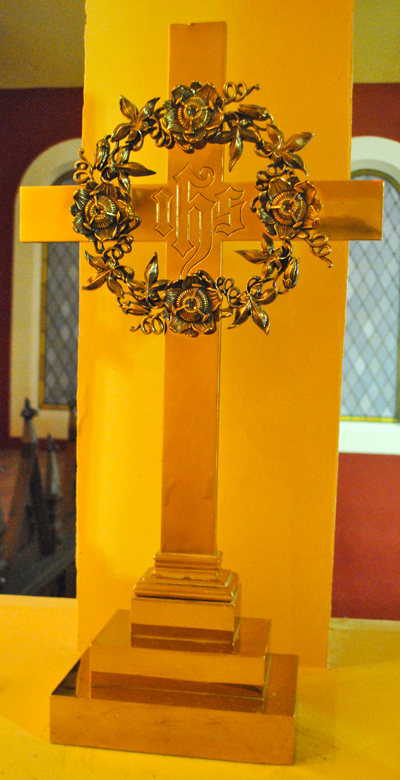
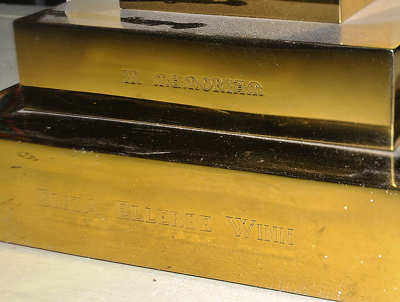
This cross was given in memory of Eliza Ellerbee Winn by Eliza E. Winn. The latter is Eliza Evans Winn (1877-1966), the daughter of Dr. and Mrs. Henry Jasper Winn of Clarendon, Texas who married A. T. (Alvin Thomas) Embrey of Fredericksburg (1874-1957), April 15, 1903. Embrey was the current Commonwealth attorney in Fredericksburg and a former legislator. They would live at 501 1/2 Hanover Street in Fredericksburg. Eliza Ellerbe Winn lived from 1838-1878 and was the first wife of Dr. Henry J. Winn and mother of Eliza Evans Winn.
The cross was added at a time when the church was undergoing visible changes both on the outside and inside in the first decade of the 20th century. There was a new spire outside. Inside was the decade from 1907-1917 when all of our stained glass windows were added with the exception of the Ascension Windows (1885) and Nativity (1943). A gift of $1,000 was made which $100 was used to paint the woodwork and $300 for graining of the pews.
St. George’s Historian Carrol H. Quenzel writes that “In the spring of 1909 the rector’s guild petitioned the vestry for permission to use regularly a brass cross and vases on the Holy Table in the church. A prominent vestryman moved that the request be granted upon the condition that flowers should be placed in the vases only on the feast days of the Church. By a vote of six to three, however, the guild’s petition was finally granted without reservations.”
At the time the cross on the holy table was an important modification for the chancel. To understand the significance of this addition, we must review church building and liturgy the century before
In his Episcopal Worship 1789 through 1840, David Holmes states the Episcopal churches in the time of our second church (1815-1848) and even part of the third (1849) were dominated more by Sermons than the Eucharist. Communion was held only a few times of year. The predominant services were Morning Prayer, the Litany and Ante-Communion. (Ante-Communion includes the first part of the eucharistic rite through the prayers of the people.)
The predominantly influence was Lutheran or Calvin. It was not a large chancel but was often dominated by a high pulpit and sounding board. A holy table was often below it, a reading table or more and font to one side. The holy table, pulpit and font were all together in a small area. All liturgical activity was grouped together in the front of the church in common view for the benefit of parishioners. Note there was no cross or flowers since they were associated with catholic forms of worship. Candles were only used for light.
This period would be superseded by the Oxford Movement which began in Europe in the 1830’s and in America after 1870. It began when English priests believed the Church of England was abandoning it catholic heritage. The Oxford Movement was a catholic revival movement. The sacraments became more important when the Eucharist became a normal occurrence. Ritualism and ceremony were re-introduced to the Church of England and subsequently Episcopal churches. The altar became the center of the church with a colorful frontal, flowers placed on them and a cross and replaced the table. Choirs were vested and processed with crosses.
Trinity had split with St. George’s over the choice of a “low” church that was evangelistic and a “high” that was more Catholic. By 1909, St. George’s which had been more “low” suddenly became high in appearance by 1909.
The Cross served was placed on the altar. The pictures show the chancel in 1960 and then the altar:

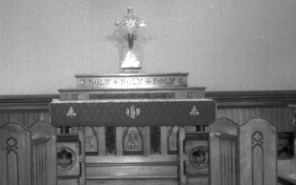
In 1994, this brass cross was stolen. By the end of 1994, the base had been found and recovered but not the cross. The suspect refused to confess or to tell where the cross was. The case was held Nov 9, 1994, the People vs. Patrick Coe. Pam Jewett Bullock identified the base but the accused did not divulge the location of the cross. Coe plead guilty and was sentenced to 3 years in jail with all but 12 months suspended. The sentence required him to pay $350 for the a substitute. (The remainder of the cross was not found until 18 months later in the Rappahannock Canal and reported in the May, 1996 newsletter.)
A month later in a congregational meeting, Charles Sydnor was asked about a replacement but he responded that no decision had been about a replacement.
This is when Christ Church, Spotsylvania made their important donation in 1995.
When their sanctuary was being extended, most of the floor was found to be rotted. While it was being replaced, a congregation member took several original 150 year old floor joists and created a cross. The joists were made from chestnut wood. It was 6 foot with 4 foot arm.
The same member took other boards and made St. George’s a cross. It recognized St. George’s giving them a gift of land during their renovation. This would be an interim cross until a permanent cross decision could be made. Then, the church would give it to a new mission church within the Diocese.
A future cross came to play in the Worship and Music’s proposed goals of April, 1994 to “resolve how the chancel was to be used- propose changes or improvements.”
While the Vestry voted in March, 1995 to accept the gift the new cross was not in the church until Dec., 1995. The gift was actually wood which would have to be constructed into a cross. Some of the wood was stored outside and got wet and had to be kiln dried.
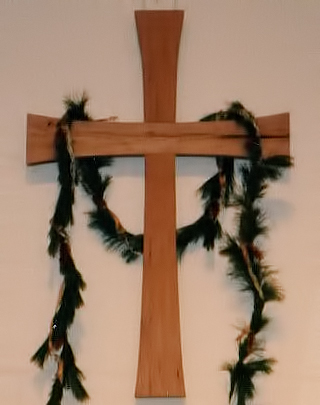
The following pictures show the inside of the church and chancel sometime between Dec. 1995 and Dec. 1999 when the reredos was re-installed.
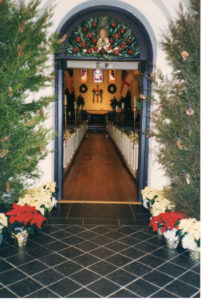

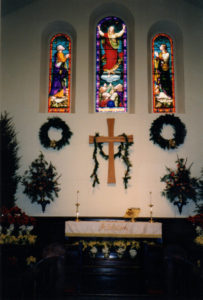
By 1998, the church began the process how the East wall would be re-decorated. Also by this time, the rest of the cross had been found in the muddy Rappahannock Canal. The cross was finally in one piece and the was re-brassed. However, with the Christ Church cross in place it would be used in Faulkner Hall until the Meditation Room was made during the church renovation from 2007-2010.
A congregational meeting was held on the East wall on June 11,1998 that considered the above issues. The meeting which included a computer rendition of the proposed changes done by Earl Baughman. Phil Makely presented the report with 3 ideas that influenced their work:
1. Fredericksburg places a high value on historic preservation
2. Wooden Cross is on loan
3. Brass cross was recovered.
Discussion over the wall involved several possibilities:
1. Was the Reredos which had been taken down going to be re-appear ? The concern was that the nave was already dark and the reredos would make it darker. Would the reredos actually improve the appearance of the east wall.
2. A new arch with a drop shadow could be created where a cross would be hung. Light would be focused on the arch to give the cross a larger appearance. Was the recovered brass cross too small for the space ? There was the recommendation in this meeting to move the Brass Cross to Faulkner Hall. It was to be renovated as part of AIM 2000.
3. Since the chancel would be involved, was it already getting too crowded ? Charles Sydnor suggested moving the choir back to the gallery and opening up the space. Currently the chancel had “traffic” problems during communion with its limited communion space. There were gallery issues that had to be addressed, such as improved air conditioning. Organist Susan Onderdonk suggested that the organ console could possibly be moved to one of the side pews in the front no longer being used.
4. Role of lighting in the project and the outline of the windows.
Charles Sydnor reminded the group Worship and Music was charged only with investigating the east wall and not whole chancel.
The consensus of the meeting was the whole chancel needed to be addressed. He had said himself that the chancel was a key part of the church and should contain the 3 main elements of our worship- initiation, proclamation and celebration. The Vestry decided that Worship and Music should continue with work but keep chancel in mind when doing so.
The reredos was the first area changed in the chancel re-decoration. It was done between 1999-2000 as this article describes.
In 1999 Worship and Music recommended restoring it without the gothic caps with a new memorial brass cross and appropriate lighting. The estimate to complete was $7,000. The original holy table was to be placed in Faulkner Hall. Mike Moyers was hired to do the work and to be done by Christmas of 1999 but it was not announced until 2000.
It was mounted flush along the east wall. It wasn’t until the Nave renovation a decade later that it was moved out to its present position which is closer to where it was in 1906.
A cross would not fit since the reredos was larger than anticipated. An ornate processional cross became the substitute and a brass maltese cross was placed on the reredos.

There were two brass maltese crosses in the chancel:
1. “In Memory of Andrew Doggett. Born September 18th 1852, Died April 13th 1916.” He was a doctor. It was place originally on the Offertory Shelf of the Chancel.
2. “In To the Glory of God And in Loving Memory of Sallie R. Doggett. Entered Into Rest March 15, 1893 “For all Thy Saints who from Thy Labors Rest, Thy Name O Jesus, Be forever Blest. Alleluia.” It was placed on the Element Table in the Chancel.
The remainder of the chancel was addressed by as whole by the Nave Renovation Committee in 2003 and a new design was part of the renovation when the church re-opened in 2009.
In 2002, the church presented the cross to a new mission church in North Stafford during a Sunday afternoon ceremoney. The mission church eventually failed and the cross went back to Christ Episcopal.
